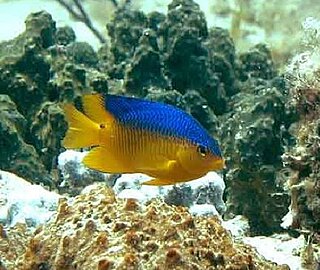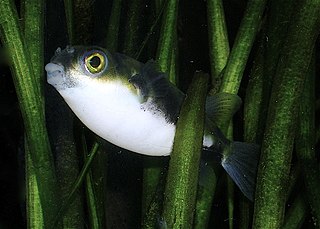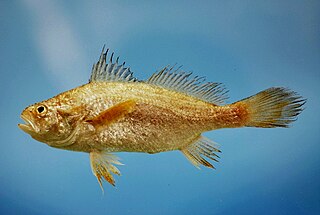
Tetraodontidae is a family of primarily marine and estuarine fish of the order Tetraodontiformes. The family includes many familiar species variously called pufferfish, puffers, balloonfish, blowfish, blowers, blowies, bubblefish, globefish, swellfish, toadfish, toadies, toadle, honey toads, sugar toads, and sea squab. They are morphologically similar to the closely related porcupinefish, which have large external spines. The scientific name refers to the four large teeth, fused into an upper and lower plate, which are used for crushing the hard shells of crustaceans and mollusks, their natural prey.

Pomacentridae is a family of ray-finned fish, comprising the damselfishes and clownfishes. This family were formerly placed in the order Perciformes but are now regarded as being incertae sedis in the subseries Ovalentaria in the clade Percomorpha. They are primarily marine, while a few species inhabit freshwater and brackish environments. They are noted for their hardy constitutions and territoriality. Many are brightly colored, so they are popular in aquaria.

Hypostomus is a genus of catfish in the family Loricariidae. They are native to tropical and subtropical South America. H. plecostomus is the popular freshwater aquarium fish formerly known as Plecostomus plecostomus. The taxonomic structure of the Loricariidae is still being expanded by scientists. Hypostomus is a highly species-rich and widely distributed catfish genus.

Astyanax is a genus of freshwater fish in the family Characidae of the order Characiformes. Some of these fish, like many of their relatives, are kept as aquarium pets and known collectively as tetras. With around 150 described species and new ones being described yearly, this genus is among the largest of the entire order; Hyphessobrycon also has more than 145 species and which one is larger at any one time depends on whether more species have been recently described in one or the other. The blind and colorless cave tetra of Mexico is a famous member of the genus, but its taxonomic position is disputed: Some recognize it as part of the Mexican tetra and this is supported by phylogenetic evidence, but others recognize the cave form as a separate species, A. jordani.

Arothron is a genus in the pufferfish family Tetraodontidae found in warm parts of the Atlantic, Indian and Pacific Ocean. These species are sometimes kept in aquaria. The largest species is A. stellatus, which can reach 1.2 m (3.9 ft) in length.

Epinephelus is a genus of marine ray-finned fish, groupers from the subfamily Epinephelinae, part of the family Serranidae, which also includes the anthias and sea basses. They are predatory fish, largely associated with reefs and are found in tropical and subtropical seas throughout the world. They are important target species for fisheries.

Leptodactylus is a genus of leptodactylid frogs. It includes the species commonly called ditch frogs or white-lipped frogs. It is very similar to Physalaemus, a close relative, and indeed the 2005 described Leptodactylus lauramiriamae is in some aspects intermediate between them. The name means ‘slender finger’, from leptos and the Greek daktylos.

Colomesus is a genus of pufferfishes confined to tropical South America. Apart from differences in size, the three species are superficially similar, being green above, white below, and patterned with black transverse bands across the dorsal surface. C. asellus is commonly found in the aquarium trade, while C. psittacus, due to its size and more specialized requirements, is not found as often.

Canthigaster is a genus in the pufferfish family (Tetraodontidae). A fish from this genus is sometimes referred to as a "toby" or a "sharpnose puffer".

Gymnothorax is a genus of fish in the family Muraenidae found in Atlantic, Indian and Pacific Ocean. With more than 120 species, it the most speciose genus of moray eels.

Scorpaenodes is a widespread genus of marine ray-finned fish belonging to the family Scorpaenidae, the scorpionfishes. The fishes in this genus are found to the Atlantic, Indian and Pacific Ocean.

Cynoscion is a genus of marine ray-finned fishes belonging to the family, Sciaenidae, the drums and croakers. These fishes are found off the coasts of North and South America in the western Atlantic and eastern Pacific Oceans. Many fishes in this genus have been given the common name weakfish.
Hamaticolax is a genus of parasitic copepods belonging to the family Bomolochidae. Its members can only be distinguished from the closely related genus Acantholochus by the presence of an accessory process on the claw of the maxillipeds. It includes the following species:

Ophidion is a genus of cusk-eels.

Gobiesox is a genus of clingfishes found in the Americas, including offshore islands. Most species inhabit coastal marine and brackish waters, but G. lanceolatus is a deep-water species found at a depth of around 300 m (980 ft), and seven species are from fast-flowing rivers and streams. These seven are the only known freshwater clingfish.

Stellifer is a genus of fish in the family Sciaenidae, the drums and croakers. It is found in New World waters. Many species are known commonly as stardrums.
Sphoeroides angusticeps, known as the narrow-headed puffer, is a species of pufferfish in the family Tetraodontidae. It is a tropical marine species endemic to the Gálapagos Islands, where it occurs at a depth range of 5 to 18 m. It reaches 25 cm in total length. The species is thought to be diurnal, hovering just above the substrate by day and burying itself at night.
Sphoeroides georgemilleri, known as the plaincheek puffer, is a species of pufferfish in the family Tetraodontidae. It is known only from the Caribbean Sea off of Colombia, where it occurs at a depth range of 1 to 151 m and is demersal, inhabiting soft bottoms. It is known to reach at least 12 cm in length.
The Brazilian puffer(Sphoeroides camila) is a species of pufferfish native to the Brazil. Previously thought to be the bandtail puffer (Sphoeroides spengleri), the species was discovered through DNA analysis. The fish lives in the western Atlantic from northern to southeastern Brazil, and some may be found in the southern Caribbean.















